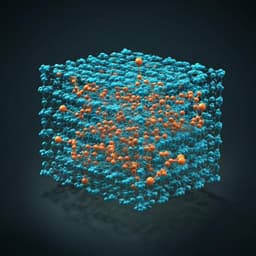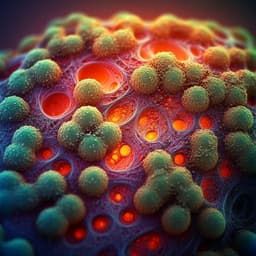
Chemistry
Halogen hydrogen-bonded organic framework (XHOF) constructed by singlet open-shell diradical for efficient photoreduction of U(VI)
L. Feng, Y. Yuan, et al.
Discover the groundbreaking research by Lijuan Feng and colleagues on a novel halogen hydrogen-bonded organic framework (XHOF-TAQ) that demonstrates exceptional stability and catalytic efficiency in reducing uranium under light. This innovative material showcases remarkable potential for environmental remediation, with an impressive uranium immobilization capacity of 1708 mg-U g⁻¹-material.
~3 min • Beginner • English
Introduction
The design and synthesis of crystalline porous framework materials has garnered great attention due to their unique attributes and chemical versatility. Crystalline porous frameworks are commonly categorized by bonding type as covalent organic frameworks (COFs), metal–organic frameworks (MOFs), and hydrogen-bonded organic frameworks (HOFs). COFs are covalently linked and stable, MOFs are built from coordination bonds between metal nodes and organic linkers with high crystallinity but low toughness, while hydrogen-bonded frameworks (HOFs/SOFs) are composed solely of organic units and offer advantages such as mild synthesis, processability, and facile reconstruction. Although hydrogen-bonded systems are known, they have only recently received attention for functional framework applications. Most hydrogen-bond-based frameworks focus on N–H or O–H interactions; however, halogens, being highly electronegative, can form strong hydrogen bonds and act as connection nodes. Conventional halogen-bond motifs are described as D…X−Y (X = halogen; D = hydrogen donor; Y = electronegative atom), used widely in supramolecular architectures. In contrast, D…X…D-type halogen-based hydrogen-bonded frameworks are rarely reported but offer ease of self-assembly, functionalization, and tunability, motivating exploration of new D…X…D connection types to expand framework families.
Organic building blocks strongly influence framework properties, providing optical and electronic functionality. Singlet open-shell diradicaloid units, first typified by Chichibabin hydrocarbons, possess quinoid/diradical resonance enabling electron delocalization and semiconducting behavior, with intriguing photonic, electronic, and magnetic properties. However, diradicals often suffer from instability, posing challenges for integrating them into robust frameworks.
Given the environmental and resource challenges posed by uranium contamination and limited reserves, efficient strategies to immobilize U(VI) by reducing it to insoluble U(IV) are of high importance. Here, using the 7,7,8,8-tetraaminoquinodimethane (TAQ) ligand and chloride anion (Cl⁻), the authors construct a halogen hydrogen-bonded organic framework (XHOF-TAQ) where Cl⁻ nodes connect TAQ via multiple Cl⁻···H hydrogen bonds into a regular 3D framework. Distinct from MOFs (metal nodes) and HOFs (direct ligand–ligand hydrogen bonds), this XHOF uses a central halogen node. Under light irradiation, TAQ forms a singlet open-shell diradical, generating excited electrons that efficiently photoreduce soluble U(VI) to U(IV), highlighting potential for uranium immobilization.
Literature Review
The study situates itself within several bodies of work: (1) framework materials—COFs, MOFs, and HOFs—highlighting their bonding modes, stability, and processability; (2) halogen bonding in supramolecular and solid-state chemistry, typically of the D…X−Y form, applied in molecular recognition, catalysis, drug design, and materials, with fewer reports on D…X…D motifs for framework construction; (3) organic diradical(oid) chemistry inspired by Chichibabin-type systems, emphasizing their quinoid/diradical resonance, semiconducting properties, and challenges of stability; (4) uranium remediation strategies via adsorption and photoreduction using advanced materials including MOFs, COFs, nanocomposites, and functional carbons. The authors note a gap in halogen-centered hydrogen-bonded frameworks using D…X…D linkages and in integrating singlet open-shell diradicals into crystalline frameworks for photocatalytic U(VI) reduction.
Methodology
Synthesis and fabrication: Terephthalamide oxime (TPAO) was prepared by amidoximation of terephthalonitrile (TPN) in DMF using NH2OH·HCl, NaOH, and Na2CO3 at 45–75 °C with stirring and subsequent separation of undissolved solids. XHOF-TAQ crystals were synthesized solvothermally by combining TPAO (0.4 mL, 0.68 mmol) and CuCl2·2H2O (0.17 g, 1.00 mmol) in DMF (5 mL), ultrasonication (10 min), then sealed heating at 95 °C for 5 days. The product was filtered, washed with DMF, and air-dried. Yield based on Cl usage: 46%. Attempts to replace CuCl2 with other MCl2 (Mn, Zn, Co, Ni, etc.) or other CuX2 (X = F, Br, I) failed to produce crystals, indicating Cu2+ catalysis and Cl− specificity are essential.
Characterization: FTIR used PerkinElmer Frontier FT-NIR/MIR. PXRD collected on Haoyuan DX-2700BH; simulated patterns via Mercury. SC-XRD on Bruker D8 Venture (Cu Kα, 150 K); structure solved with Olex2 (XS) and refined with XL; space group C2/c; CCDC 2096137. Thermal stability by TGA (Netzsch STA 449 F5 Jupiter) from RT to 800 °C at 10 °C min−1 under N2. XPS (Kratos AXIS SUPRA) for elemental states; valence band XPS used to determine Ev. SEM/EDS for morphology and elemental mapping. MS (Bruker ultrafleXtreme MALDI-TOF) and 1H NMR (Bruker Avance 400; DMSO‑d6, TMS) for ligand identity. EPR (Bruker A300-12) for diradical signals and temperature dependence.
Computations: DFT with Gaussian 09, B3LYP functional. LANL2DZ ECP for Cl; 6‑31G+(d,p) for C, N, H. SOMOs, spin density, and density of states computed; vibrational analyses to confirm minima; NBO analysis for population.
Optical measurements: UV–vis DRS (Shimadzu UV‑3600) with BaSO4 standard; Tauc analysis to estimate band gap.
Photocatalysis experiments: Simulated sunlight from a 300 W Xe lamp (200–800 nm, 1 kW m−2). Catalyst dispersed in 20 mL of 50 ppm U(VI) in DMF without sacrificial agents. Suspensions stirred in dark for 20 min before illumination. Aliquots (100 μL) taken periodically, filtered (nylon syringe membrane), and U(VI) quantified by ICP‑MS (Agilent ICPMS7899). Dosage optimization performed over 0.01–0.20 g L−1. Interference studies: anions (as Na salts, 10 mM) and cations (as chlorides, 10 mM); mixed interfering metal ions (as nitrates, each 10 mM). Post-reaction PXRD assessed structural integrity.
Key Findings
- XHOF-TAQ structure: SC-XRD reveals monoclinic C2/c space group with asymmetric unit containing two Cl− and one TAQ. Each Cl− forms three Cl−···H–N hydrogen bonds with three TAQ ligands, creating a planar triangular Cl−–H3 motif; H-bond lengths 2.33, 2.39, and 2.44 Å. Nearest Cl−–Cl− plane-center distance 4.36 Å, indicating minimal inter-halide interactions and enabling extended 3D connectivity via TAQ.
- Ligand transformation: Starting TPAO is converted in situ to TAQ during solvothermal synthesis, evidenced by elemental analysis (no O), EDS (N, Cl present; O absent), MS (163 Da for TAQ), and 1H NMR. Cu2+ catalyzes loss of oxime OH groups to form TAQ; other MCl2 or CuX2 (X = F, Br, I) fail to yield crystals.
- Electronic interactions: XPS shows Cl 2p binding energy shifts from CuCl2 (200.40/198.82 eV) to XHOF‑TAQ (198.82/197.23 eV), indicating increased electron density on Cl− due to electron sharing from electron-rich TAQ, which also enhances TAQ air stability within the framework.
- Stability: PXRD matches simulation, indicating phase purity. No phase change after 6 h exposure to various solvents; retains crystal structure after 1 year in air. TGA shows negligible weight loss before 280 °C; decomposition between 280–363 °C; near total weight loss above 363 °C.
- Photoreduction of U(VI): With 0.05 g L−1 catalyst, immobilization capacity reaches 1708 mg‑U g−1‑material and a rate of 34.16 mg g−1 min−1 under light, outperforming many reported materials. Under 0.10 g L−1 dosage, ~92.0% U(VI) immobilization within 90 min (capacity ~921.7 mg‑U g−1). High-resolution U 4f XPS shows conversion: U(VI) peaks at 392.68/381.87 eV to U(IV) peaks at 392.01/381.16 eV after photocatalysis. PXRD of used catalyst indicates structural integrity retained.
- Diradical evidence and electronic structure: EPR shows a signal at g = 2.00 only under illumination; temperature-dependent EPR fitted by Bleaney–Bowers gives singlet–triplet gap ΔE = −1.22 kcal mol−1, consistent with a singlet diradical state under light. DFT finds TAQ singlet open-shell diradical state lower than closed-shell by 1.21 kcal mol−1; SOMOs (α/β) show disjoint character; spin density localized mainly at C7/C8.
- Band structure: Valence band edge Ev = 2.56 eV (VB XPS). DRS/Tauc plot yields Eg = 2.43 eV; DOS calculations agree. Conduction band edge Ec ≈ 0.13 eV, enabling thermodynamically feasible photoreduction of U(VI).
- Environmental factors: Anions—CO3^2− enhances efficiency; Cl− and NO3− have slight effects (10 mM). Cations—K+ enhances; Ba2+ shows no interference (10 mM). Competing transition metal cations (e.g., Ni2+, Co2+, Zn2+) can capture excited electrons, partially reducing U(VI) photoreduction; nevertheless, uranium immobilization capacity is at least 3.68× higher than for these metals. In a multi-metal ion mixture (each ~50× U molarity), U(VI) photoreduction efficiency remains ~72.0% within 120 min.
Discussion
The work demonstrates a new class of crystalline framework—halogen hydrogen-bonded organic framework (XHOF)—constructed via Cl−-centered multi-hydrogen bonds (D…X…D motif), distinct from MOFs, COFs, and conventional HOFs. Using an electron-rich TAQ ligand that adopts a singlet open-shell diradical under illumination, XHOF‑TAQ generates excited electrons that selectively reduce U(VI) to insoluble U(IV), effectively immobilizing uranium from solution. Structural analyses (SC‑XRD) establish robust Cl−···H–N triangular motifs that, together with electron sharing between TAQ and Cl−, impart high chemical, thermal, and long-term air stability. Spectroscopic and computational evidence (EPR, DFT, VB XPS, DRS) corroborate the diradical character, favorable band positions (Ev = 2.56 eV, Eg = 2.43 eV, Ec ≈ 0.13 eV), and n-type semiconducting behavior that underpin efficient photoreduction. The catalyst maintains performance under various anionic/cationic environments and shows selectivity towards U(VI) even amidst high concentrations of competing metal ions. These findings directly address the need for efficient, selective, and stable photocatalysts for uranium immobilization, expanding the design palette for crystalline frameworks by leveraging halogen-centered hydrogen-bond connectivity and diradical ligands.
Conclusion
This study introduces XHOF‑TAQ, a halogen hydrogen-bonded organic framework built from Cl−···H–N interactions that connect TAQ ligands into a robust 3D crystal. It is, to the authors' knowledge, the first demonstration of integrating a chemically labile singlet open-shell diradical (TAQ) into a crystalline framework via solvothermal synthesis, with electron sharing to Cl− enhancing stability. XHOF‑TAQ exhibits high photoreductive performance for U(VI) to U(IV), achieving a capacity of 1708 mg‑U g−1 and rapid kinetics, while retaining structural integrity and selectivity in the presence of various competing ions. The work provides a promising strategy for uranium immobilization and opens a new direction for the synthesis of crystalline frameworks based on halogen-centered hydrogen bonds and functional diradical ligands. Future research may explore alternative halogen nodes, broader ligand designs, optimization for aqueous/real-waste matrices, and device-level photoreactors for scalable deployment.
Limitations
- Synthesis constraints: Crystalline products were obtained only with CuCl2·2H2O; other MCl2 (Mn, Zn, Co, Ni, etc.) and other halides (CuX2, X = F, Br, I) did not yield crystals, indicating limited generality of current conditions and a dependence on Cl− as the connecting node and Cu2+ catalysis.
- Operational requirements: Photoreduction requires light irradiation; neither light alone nor catalyst alone reduced U(VI). Certain coexisting cations (e.g., Ni2+, Co2+, Zn2+) compete for excited electrons and partially suppress U(VI) reduction.
- Testing medium: Photocatalytic experiments were performed in DMF with simulated sunlight; performance in complex real aqueous waste streams and under natural sunlight conditions was not reported.
Related Publications
Explore these studies to deepen your understanding of the subject.







